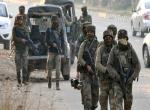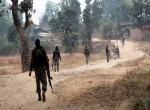Naxalites, Maoists, Left Wing extremists call them what you will, (for convenience I shall call them Naxalite) have virtually taken over about 160 districts of India. That covers more than a quarter of the whole country.
All of these are located in the heart of India ---Chhattisgarh, Jharkhand, Eastern Bihar, parts of West Bengal, South Eastern Maharashtra, South Western M.P, Orissa and North Western Andhra Pradesh. In Andhra Pradesh in the Telangana Region the administration and the police, by forceful action, have been able to regain control and the Naxalites are on the run from there. In Chhattisgarh, Orissa and South Eastern Mahrashtra, however, the Naxalites reign supreme.
As is well known the extreme Left Wing armed movement originated in Naxalbari of Darjeeling District of West Bengal as a revolutionary attempt to overthrow the legally constituted government. Violence was the creed of this movement and murder of innocent people, including government servants and policemen, was the weapon used to try and overawe the administrative structure of the State. Siddharth Shankar Ray, as Chief Minister of West Bengal initiated the campaign against Naxalism, but it was the Left Front Government led by Jyoti Basu which effectively uprooted Naxalism from the place of origin. Even though there are areas in West Bengal which have Left Wing extremism even today, for example the Lalgarh area, by and large in West Bengal the situation is manageable.
In the Telangana area of old Hyderabad State there was strong Left Wing armed resistance to zamindari in the Nizam’s dominion, but after the Police Action when Hyderabad State was taken over, the newly appointed Commissioner of that region, V. Nanjappa, very effectively curbed militancy. The cause of that militancy was the iniquitous exploitation of the zamindari regime of the Nizam’s government, just as in West Bengal it was the Cornwallis Permanent Settlement and the misdeeds of the zamidars which gave rise to peasant unrest. One reason why Naxalism was controlled in West Bengal was that the Jyoti Basu Government introduced genuine land reforms which created a climate of hope in rural Bengal and weaned away people from Left Wing extremism. The second reason, of course, is that the parties of the Left Front voluntarily accepted our democratic system and electoral politics drove away the Naxalites. Fortunately in Andhra Pradesh right from the time when N.T. Rama Rao became Chief Minister the administration took a firm decision to counter Naxalism and this took the following form:-
- The police force was reorganised, strengthened, properly trained and equipped and a strike force called the Greyhounds was constituted. More police stations were opened and every police station was strengthened so that it became impregnable to Naxalite attacks. These police stations were then used as centres from which anti Naxalaite operations could be launched.
- The Intelligence set up was strengthened and gradually information about Naxalite activities began to reach the police, which launched immediate strikes if the information was reliable and could be acted upon. This resulted in a number of successful encounters in which the police had the upper hand.
- The police adopted a proactive policy of area domination and there was penetration of security forces into erstwhile Naxalite strongholds.
- Simultaneously the district administration was also strengthened and made proactive. Police measures were paralleled by a thrust for development and this began to eat into the Naxalite base. Today the position is that government has recaptured most of the Naxalite affected area of Telangana and the Naxalites have been driven out to find shelter in Chhattisgarh, Maharashtra and Orissa. There are lessons to be learnt from the successful operations of the Andhra Pradesh Government.
What are the Naxalites? What is their objective? How do they operate? Who supports them? What is government’s reaction to Naxalite activities? How seriously does government view the Naxalite problem? The first fact to be remembered is that in the so-called Red Corridor, or Liberated Areas as they are called, the writ of government does not run. The situation here is much worse than it ever was in Nagaland or Mizoram at the height of insurgency. In the North East government decided very early that it would prove to the insurgents that they cannot defeat the Indian State by force of arms. A large number of units of the armed police were inducted into the insurgent hit areas, but overall operational command was given to the army, which took control of anti-insurgency operations. There was never a time when the police or the army withdrew from Nagaland and Mizoram or left space which the insurgents could take over. These areas have always been treated as frontier areas even by the British and the civil administration only had a presence there through political agents or deputy commissioners reporting directly to the Governor of Assam. The policing was provided by the Assam Rifles and, therefore, when insurgency endangered the integrity of India the army took over this policing and administrative role. At the same time a regular administrative structure was slowly created, first in the Union Territories carved out of Assam by way of Nagaland and Mizoram, with appointment of district officers and superintendents of police, setting up of police stations and creation of development blocks. As the insurgents learnt the hard way that they cannot defeat the Indian Army many of them began to come into the mainstream and over time it was possible to democratise the administration and to convert the Union Territories into States of the Union. Today Mizoram is peaceful and insurgency in Nagaland is confined only to some pockets and is very much under control. This is not the picture in the Naxalite dominated districts of India.
The National Centre for Human Settlements and Environment (NCHSE) did an evaluation of five Naxalite dominated districts of Chhattisgarh on behalf of the Planning Commission to see how various development projects are progressing. The findings of the NCHSE team were that the normal district administration is only a façade and operates at the mercy of the Naxalites. The Naxalites do not allow school buildings to be constructed because they suspect they can be used by security forces and, therefore, school buildings are blown up. Education, therefore, has suffered in these areas. No development project can be undertaken unless the Naxalites want it. In one case of Dantewada District, the details of which are available but are not being revealed for security reasons, a contractor from Nagpur was permitted to undertake the construction of a road, for which he had to pay the local dalam or armed group of Naxalites a sum of rupees twenty lakhs. He paid this, but another dalam then demanded a similar amount, which he could not pay. He was shot dead. His widow, obviously a woman of great courage, came down from Nagpur and upbraided the Naxalites for breach of promise. One dalam apologized, but she still remains a widow because her husband’s life could not be restored. The road, incidentally, was not built.
In the Naxalite area government’s primary health care system hardly functions. The revenue courts do not function, land records are where they were prior to the Naxalite movement, civil litigation stands informally transferred to so-called Naxalite courts, where there is no real justice, the forest department exists at the mercy of the Naxalites and criminal justice itself has become a function of kangaroo courts. The only system which functions is the excellent Public Distribution System (PDS) of Chhattisgarh but there, too, the Naxalites insist that lorries carrying PDS goods will be handled by them and they will do the actual distribution because that gains them credit.
The Naxalites operate at two levels. One is the normal organisation of villagers through which contact is maintained with the administration. The other is armed dalams where large groups of insurgents armed with modern weapons freely roam the area. The villagers are terrified and dare not inform the security forces about Naxalite movement. The security forces, too, send out patrols and pressurise the villagers, but ultimately the police can only beat up people whereas the Naxalites kill them. Whether it is a beating at the hands of security forces or death at the hands of Naxalites, the poor tribals of the Naxalite infested zone are today the most miserable people on earth. That is what the Naxalites have done to them.
Who are these Naxalites? How do I know about them? I would restrict my comments to the Bastar Division of Chhattisgarh only. From the time when it was a part of Madhya Pradesh, Bastar was the largest district in India and was a part of Raipur Division. One area called Abuj Marh was the only Inner Line area located within the heartland of India in that entry into the Marh was by permission of the D.C. of Bastar, there was no revenue survey or settlement, there was jhoom cultivation, there was neither a revenue or police presence and it is only the Tribal Welfare Department which ran schools and had a presence in the Marh. The region was tiger infested and in one village man-eaters ate the entire population of thirty-eight people, including the village school teacher. The Forest Department eventually launched a campaign to eliminate the man-eaters and two of them were shot dead. The whole of Bastar was beautiful, unspoiled and totally peaceful. The Maria, Muria, Dandami Maria, Hill Maria, etc., are all Gond tribes which inhabit Bastar. Bastar was originally a princely state in which the much smaller princely state of Kanker was merged. Outside intervention came through two major projects, the Dandakaranya Project centred at Pakhanjore for rehabilitation of East Bengal refugees and the Bailadilla Project for mining iron ore. Bastar is a mineral rich region in which there is some of the purest iron ore in the world called blue dust, zinc, tin, precious stones like corundum, coal - name it you will find it in Bastar. It also has beautiful forests with the teak zone located on dike merging with schist and gneiss of the sal zone, moving towards semi moist deciduous forests of Bailadilla and South Bastar. There is poverty, but no starvation because nature is bountiful in the district. Unfortunately exploitation by outsiders in the Dandakaranya Project and the Bailadilla iron ore mines did lead to displacement, inequality, loss of livelihood, deforestation and pollution of rivers. This is a major cause of discontent in Bastar.
As for my credentials, I had been Director, Tribal and Harijan Welfare of Madhya Pradesh and have very extensively toured Bastar, then the most important tribal district in India. Thereafter as Secretary of the Environmental Group of Departments, which included forests, I had a great deal to do with Bastar. One signal contribution I made was to abandon tropical pine plantation in Bastar. Under the sponsorship of the World Bank the Government of India and the Government of Madhya Pradesh, in Machkot - Tiria on 400 acres cut down the beautiful mixed forests and introduced monoculture of Pinus Carribia for development of pulp wood plantation to feed the paper factories of Sweden. The idea was to grow this species in 40, 000 acres, thus virtually destroying the beautiful forests of Machkot Tiria. Despite immense pressure from the Government of India to take up the project because it would give that government foreign exchange I stoutly resisted it and contributed to saving the indigenous forests of Bastar. Today the tropical pine is in decline and indigenous species have made a come back.
In the end of 1983 when I was still in service Arjun Singh, the then Chief Minister of Madhya Pradesh, asked me to tour South Bastar where the beginnings of Naxalism were being felt. I toured extensively and what I found was that Andhraite Naxalites under some pressure in that State had penetrated into Bastar. Despite the poverty of the region, despite displacement by Dandakaranya and Bailadilla, there was no home grown militancy. Bastar was a ryotwari district and land ownership of the tribals was protected by the Madhya Pradesh Land Revenue Code. I told Arjun Singh that we could accelerate the pace of development, but through projects which tribals could assimilate. We could post officers and staff of known efficiency and integrity and we could take police action. However, nowhere did I find even one worker of any political party, including the Congress, BJP and the Left who mingled with the people and educated them on the dangers of Naxalism and militancy. I told him that this task could not be performed by civil servants. It is this political vacuum which has been invaded and taken over by the Naxalites. Even here, when Digvijay Singh was Chief Minister, a very fine IPS officer called A.N. Pathak, as IG anti Naxalite operations, camped in the deep jungles of South Bastar and virtually drove out the Naxalites. However, under pressure from the so-called liberal activists the Digvijay Government stopped these operations and ordered Pathak to withdraw from Bastar with a major part of his force. The police lost the initiative, the Naxalite flooded in and that was the beginning of the present sorry state in Chhattisgarh.
My third link with Bastar is that Kamal Nath, as Union Minister for Forests and Environment, appointed me Chairman of a committee to look into the environmental impact of the proposed Indravati Project in Bastar. This was largely a hydel project, with some irrigation. I shot down the project in flames because it would have caused immense environmental damage both to the river and to the forests through which it flowed. My report was accepted in toto and the project shelved. I have given this background because today the picture is very different and Bastar is the least safe place in India. Neither in Kashmir nor in the North East have the security forces ever given up their role of dominating the area. In Bastar the exact reverse is true and it is the Naxalites who dominate.
This brings me to the questions I asked about the Naxalites. The so-called activists, B.D. Sharma, Binayak Sen, Arundhati Roy, Swami Agnivesh, Dr. Hargopal and large numbers of JNU brand liberals all look on the Naxalites as people leading a revolution against the heartless, capitalist, anti people and anti tribal State. To them Naxalite terror is a war of liberation. If it is a war then surely the Geneva Convention should apply. Just a few days ago Naxalites entered a village in Gadhchiroli District of Maharashtra and decapitated two villagers and abducted ten others. In Jharkhand a police inspector was abducted and beheaded. In Bastar in a single ambush seventy-seven jawans of CRP were killed. The Naxalites target the elected representatives, as witnessed by abduction of a Member of the Orissa Legislature. They have destroyed the panchayat raj institutions and when Alex Paul Menon, Collector of Sukma was addressing a panchayat sammelan the Naxalites brutally murdered two of his security officers and abducted him. The Naxalites have destroyed education by blowing up schools, they have disrupted the health care system, they do not allow development works to be undertaken so that the problems of poverty cannot be tackled, they blackmail people and at the point of a gun extort money from them, so much so that even the poorest villagers who go to market have to pay their tithe to the Naxalites. A bus operator can run his bus only on routes permitted by the Naxalites and the timings scheduled by them. The murder of policemen is considered an act of merit, including by their pseudo intellectual supporters. Abduction is now a major weapon for forcing government to surrender to all their demands. This government seems to be doing so quite willingly. This is a total negation of government and it is high time that government went on the offensive and recaptured the Naxalite dominated areas in order to establish democratic civilian government there. Unfortunately neither Chidambaram nor the Home Ministry have realised the seriousness of the problem, which is why our responses to Naxalite terror are ad hoc, sporadic and based on expediency. We need to sweep the Naxalite hit areas clean of terrorists. For this purpose we need to do the following:-
- In all hostage-taking incidents we should refuse to negotiate and make it clear that if need be we are prepared to lose the hostage. However, the retaliatory strikes will be swift, deadly, if necessary brutal and they will be effective.
- The Andhra Pradesh tactics of converting all police stations into strongholds and then using them for mounting anti Naxalite operations must be adopted and immediately implemented.
- The police force of the Naxalite hit States must be strengthened, equipped, armed, trained and led by officers who inspire confidence so that the State Police becomes the main strike force. It is only when KPS Gill re-energised and re-organised the Punjab Police that with the help of central police forces and the army he was able to restore order in the Punjab. In the Naxalite hit districts of Chhattisgarh our evaluation study found that even today the people of Bastar are not inimical to the Chhattisgarh Police and if that force is strengthened it can take on the Naxalites.
- Surveillance from the air is not enough. A sufficiency of transport helicopters to quickly move forces to where they are needed and armed helicopters which can be used to strafe Naxalites who have laid an ambush or are moving around in large numbers is the need of the hour and there should be no hesitation in this behalf.
- The armoury of the police must include heavy weapons so that a police party which is ambushed can retaliate with high explosives fired from mortars, rocket launchers, etc. Armoured fighting vehicles of the BMP type should also be provided to the police. The objective is that every ambush must be successfully countered and heavy casualties inflicted on the attackers.
- There should be aggressive patrolling, the objective of which is to bring the Naxalite dalams to encounter. With proper planning it should be possible to knock out a whole dalam in a single encounter. If heavy causalities are suffered by the Naxalites police morale will rise and the Naxalites will find it difficult to gain recruits as their morale plummets.
- At present the situation is so serious that in target areas we need Corps and Division level exercises in jungle warfare. On paper these would be training exercises, but the objective would be to flush out the Naxalites and drive them into the arms of security forces, mainly police and central armed police forces which could then liquidate them. It is very doubtful that the Naxalites would attack the army, but if they are stupid enough to do so they would be given short shrift. As an area is cleared normal district administration must be restored very quickly and area normalised.
- There is a theory, to which obviously Chidambaram and Montek Singh Ahluwalia subscribe, that development will end the Naxalite problem. Development is possible only in an environment of peace and security and as things stand today the Naxalites do not permit development. Therefore, restoration of peace is the number one priority of the government. Initially the steps taken would be harsh and even brutal and the liberal brigade would raise a howl. Let them. Ignore them if possible, suppress them if necessary, but do not lose sight of the objective of bringing India back to normal rule in which a democratic administration is re-established. Once that happens bring everyone back on board so that development programmes and programmes of assimilation to which the tribals can relate can be launched and tribal grievances removed.
One thing does pain me. Our intelligence agencies, central and state, seem to be quite good at the surveillance of political rivals of government. When it comes to intelligence about the movement of large bodies of armed people who in broad day light could abduct a District Collector, there seems to be a total intelligence silence. Nehchal Singh Sandhu is a first class intelligence officer, who is Director of the Intelligence Bureau. His operational record is outstanding. My prayer to him would be that he organises our intelligence services in such a way that whereas their overseeing of terrorism imported from Pakistan or encouraged to grow in India by that country remains strong, an equally strong intelligence network is built up about Left Wing extremism. At the present moment at an operational level that networks seems to be weak. The Pakistan- China orientation of the Intelligence Bureau would have to include a highly effective division whose sole concern is Left Wing extremism. Nehchal would do a great service to the nation if under his leadership the Intelligence Bureau becomes that organ of the State which the Naxalites fear the most
Published Date: 11th May 2012









Post new comment